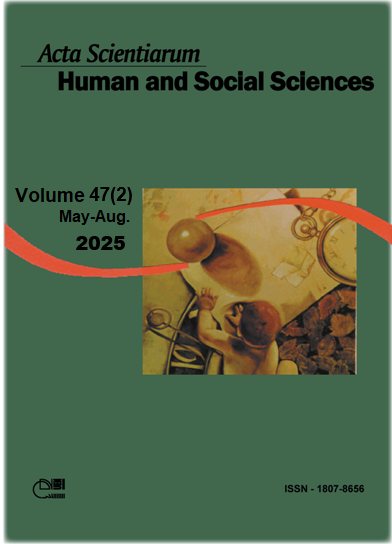Xenorracismo e interseccionalidades: um estudo exploratório-descritivo com migrantes africanos(as) no contexto brasileiro
Resumen
O objetivo desta pesquisa é compreender as dinâmicas do xenorracismo e suas interseccionalidades em relação aos marcadores identitários nas narrativas de migrantes africanos(as) no Brasil. Este estudo é de natureza exploratória-descritiva e utiliza uma abordagem qualitativa com amostragem não probabilística por conveniência. A metodologia de campo adotada foi a técnica de snowball, na qual cada participante indicou o próximo, resultando em uma amostra final de seis migrantes: três homens cisgêneros e três mulheres cisgêneros, oriundos de diferentes nacionalidades africanas e atualmente residentes no Brasil. As entrevistas foram analisadas à luz da Análise Crítica do Discurso (ACD), conforme a abordagem de Fairclough (2013). Os resultados demonstram como categorias identitárias - como raça, gênero, orientação sexual, língua e classe social - influenciam as experiências de discriminação enfrentadas pelos migrantes africanos(as). A partir das auto-narrativas, foram identificadas diversas formas de discriminação em esferas psicossociais distintas, como no ambiente de trabalho, na educação e nas relações interpessoais cotidianas, frequentemente exacerbadas pelos marcadores identitários dos participantes. A pesquisa ressalta que a experiência da discriminação é vivenciada de maneira singular, ilustrando como processos subjetivos interculturais moldam as trajetórias de cada migrante, resultando em um entrelaçamento de categorias identitárias que se manifestam em tapeçarias intersubjetivas. Assim, além de evidenciar os desafios enfrentados por esses migrantes no contexto contemporâneo dos fluxos migratórios no Sul Global, o estudo sublinha a importância de uma análise interseccional para orientar atores sociais, serviços e formuladores de políticas voltadas à comunidade de migrantes africanos(as), visando promover ações equitativas que combatam as violências institucionais e simbólicas que marcam suas trajetórias no Brasil.
Descargas
Citas
Associação Brasileira de Pesquisadores Negros. (2021). Evasão acadêmica e desafios de inclusão para estudantes migrantes africanos no Brasil. ABPN.
Nascimento, A. (2016). Discriminação: realidade racial. In A. Nascimento, O genocídio do negro brasileiro: processo de um racismo mascarado (Cap. 7, pp. 82-88). Editora Perspectiva S.A.
Elhajji, M. (2023). Percursos migratórios. In M. Elhajji, O intercultural migrante: teorias & análises (Cap.1, pp. 27-58). Editora Fi. DOI: https://doi.org/10.22350/9786559176830
Barrett, R., Cramer, J., & McGowan, K. (2022). Language, categorization, and social identities. In R. Lippi-Green, English with an accent: language, ideology, and discrimination in the United States (Cap. 2, pp. 20-42). Routledge.
Bourdieu, P. (1991). On symbolic power. In P. Bourdieu, Language and symbolic power (Cap.7, pp. 163-171). Harvard University Press.
Brasil. Ministério das Relações Exteriores. (2023). Comunidades brasileiras no exterior - estatísticas 2023. https://www.gov.br/mre/pt-br/assuntos/portal-consular/comunidades-brasileiras-no-exterior-estatisticas-2023
Collins, P. H. (2004). Why black sexual politics? In P. H. Collins, Black sexual politics: african americans, gender, and the new racism (Cap. 1, pp. 5-31). Routledge.
Crenshaw, K. (1992). Race, gender, and sexual harassment. Southern California Law Review, 65(1), 1467-1476.
Fairclough, N. (2013). Section A: language, ideology and power. In N.Fairclough, Critical discourse analysis: the critical study of language (pp. 23-69). Routledge.
Faustino, M., & Oliveira, M. (2022). Xeno-racismo ou xenofobia racializada? Problematizando a hospitalidade seletiva aos estrangeiros no Brasil. REMHU: Revista Interdisciplinar da Mobilidade Humana, 29(63), 193-210. https://doi.org/10.1590/1980-85852503880006312
Gil, A. (2008). Métodos das ciências sociais. In A. Gil, Métodos e técnicas de pesquisa social (Cap. 2, pp. 29-42). Editora Atlas.
Hooks, B. (2000). Feminism and class power. In B. Hooks, Where we stand: class matters (Cap. 11, pp. 105-150). Routledge.
Méndez-Fierros, H., & Astudillo, R. (2023). Representaciones sociales de racismo y exclusión social: migraciones haitianas contemporáneas en América Latina. REMHU: Revista Interdisciplinar da Mobilidade Humana, 31(1), 161-176. https://doi.org/10.1590/1980-85852503880006710
Nascimento, A. (2016). O embranquecimento da raça: uma estratégia de genocídio In A. Nascimento, O genocídio do negro brasileiro: processo de um racismo mascarado (pp. 69-78). Editora Perspectiva.
Observatório das Migrações Internacionais. (2020). Relatório Anual 2020: Migração Internacional no Brasil. Ministério da Justiça e Segurança Pública. http://obmigra.mj.gov.br
Observatório das Migrações Internacionais. (2022). Migrações internacionais e mobilidade no Brasil: desafios e oportunidades. Ministério da Justiça e Segurança Pública.
Organização Internacional do Trabalho. (2022). Labour overview of Latin America and the Caribbean. OIT. https://www.ilo.org/publications/2022-labour-overview-latin-america-and-caribbean
Parker, C., Scott, S., & Geddes, A. (2019). Snowball sampling. SAGE Publications.
Patarra, N., & Fernandes, D. (2011). Brasil: país de imigração. Revista Internacional em Língua Portuguesa: Migrações, 3(24), 65-96.
Rosário, M. (2024, 4 de novembro). Imigrante morre após passar mal no Aeroporto de Guarulhos. O Globo.https://oglobo.globo.com/brasil/sao-paulo/noticia/2024/09/04/imigrante-morre-apos-passar-mal-no-aeroporto-de-guarulhos.ghtml
Santos, N. (1983). Antecedentes históricos. In N. S. Souza, Tornar-se negro: as vicissitudes da identidade do negro brasileiro em ascensão social (pp. 10-35). Edições Graal.
Sivanandan, A. (1976). Race, class and the state: the black experience in Britain: for Wesley Dick - poet and prisoner in some answer to his questions. Race & Class, 17(4), 347-368. https://doi.org/10.1177/030639687601700401
Seyferth, G. (2002). Colonização, imigração e a questão racial no Brasil. Revista USP, 1(53), 117-149. https://doi.org/10.11606/issn.2316-9036.v0i53p117-149
Derechos de autor 2025 Brunno Ewerton, Mohammed Elhajji , Catalina Revollo Pardo

Esta obra está bajo licencia internacional Creative Commons Reconocimiento 4.0.
DECLARAÇÃO DE ORIGINALIDADE E DIREITOS AUTORAIS
Declaro que o presente artigo é original, não tendo sido submetido à publicação em qualquer outro periódico nacional ou internacional, quer seja em parte ou em sua totalidade.
Os direitos autorais pertencem exclusivamente aos autores. Os direitos de licenciamento utilizados pelo periódico é a licença Creative Commons Attribution 4.0 (CC BY 4.0): são permitidos o acompartilhamento (cópia e distribuição do material em qualqer meio ou formato) e adaptação (remix, transformação e criação de material a partir do conteúdo assim licenciado para quaisquer fins, inclusive comerciais.
Recomenda-se a leitura desse link para maiores informações sobre o tema: fornecimento de créditos e referências de forma correta, entre outros detalhes cruciais para uso adequado do material licenciado.

























